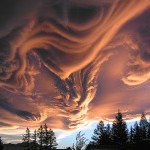Category: Arts
Created by: Donphk
Number of Blossarys: 1
Often referred to as UFOs due their flying saucer shape, lenticular clouds are stationary lens-shaped clouds that form at high altitudes, normally aligned at right-angles to the wind direction. When stable moist air flows over a mountain or a range of mountains, a series of standing waves are often formed on the downwind side. If the temperature at the crest of the wave drops to the dew point, moisture in the air may condense to form lenticular clouds. Under certain conditions, long strings of lenticular clouds can form, creating a formation known as a wave cloud. The wave systems cause large vertical air movements and so enough water vapor may condense to produce precipitation. Since lenticular clouds generally do not form over low-lying or flat terrain, most people have never seen one and are not aware clouds with that shape can exist. Bright colors (called irisation) are sometimes seen along the edge of lenticular clouds. These clouds have also been known to form in cases where a mountain does not exist, but rather as the result of shear winds created by a front.
Często określane jako UFO ze względu na ich kształt latający spodek, soczewkowe chmury są stacjonarne-w kształcie chmury, które tworzą na dużych wysokościach, normalnie wyrównywany prostopadle do kierunku wiatru. Gdy stabilne wilgotne powietrze przepływa przez góry i pasmo górskie, seria fale stojące często powstają po stronie zawietrznej. Jeśli temperatura w szczytu fali spadnie do punktu rosy, wilgoci w powietrzu może skondensować do chmury soczewkowate formy. Pod pewnymi warunkami mogą tworzyć długie łańcuchy chmury soczewkowate, tworzenie formacji, znany jako chmura fala. Systemy fala powodują duże powietrza pionowe ruchy i tak wystarczająco dużo pary wodnej może skondensować do wytwarzania opadów. , Ponieważ chmury soczewkowate zwykle nie tworzą nad nisko lub płaski teren, większość ludzi nigdy nie widziałem jeden i są chmury nie pamiętać z tego kształtu może istnieć. Jasne kolory (tzw. irisation) są czasami widoczne wzdłuż krawędzi soczewkowe chmury. Chmury te są również znane do formularza, w przypadkach gdzie góra nie istnieje, ale raczej jako wynik ścinanie wiatru stworzony przez front.


 English (EN)
English (EN) 